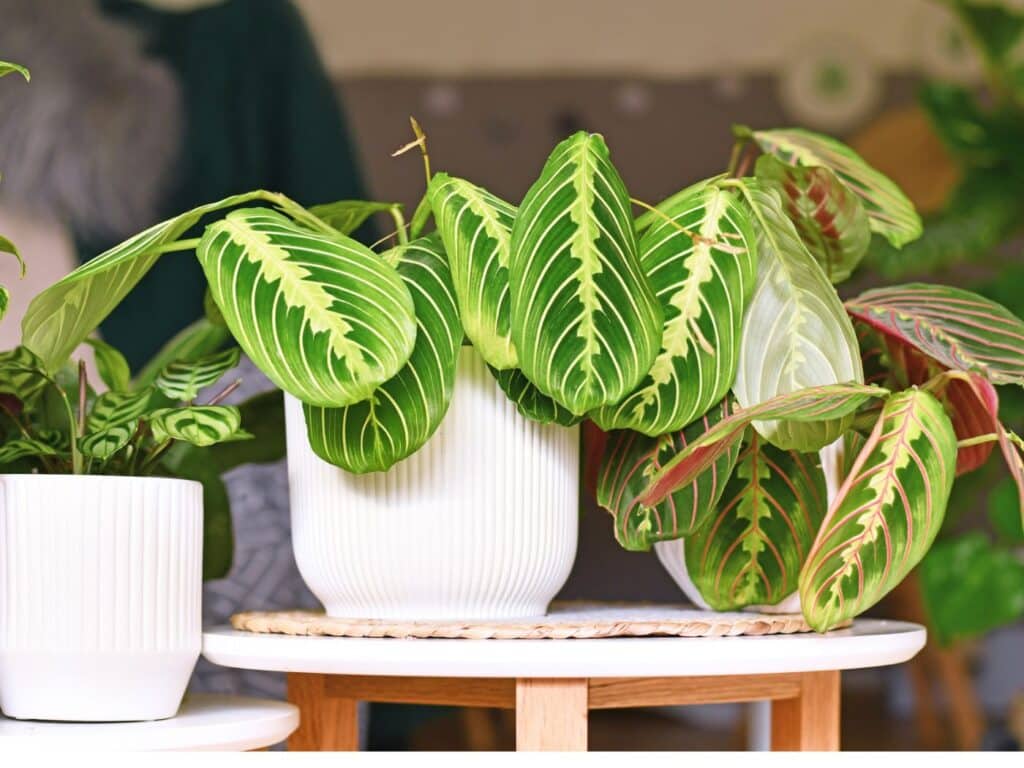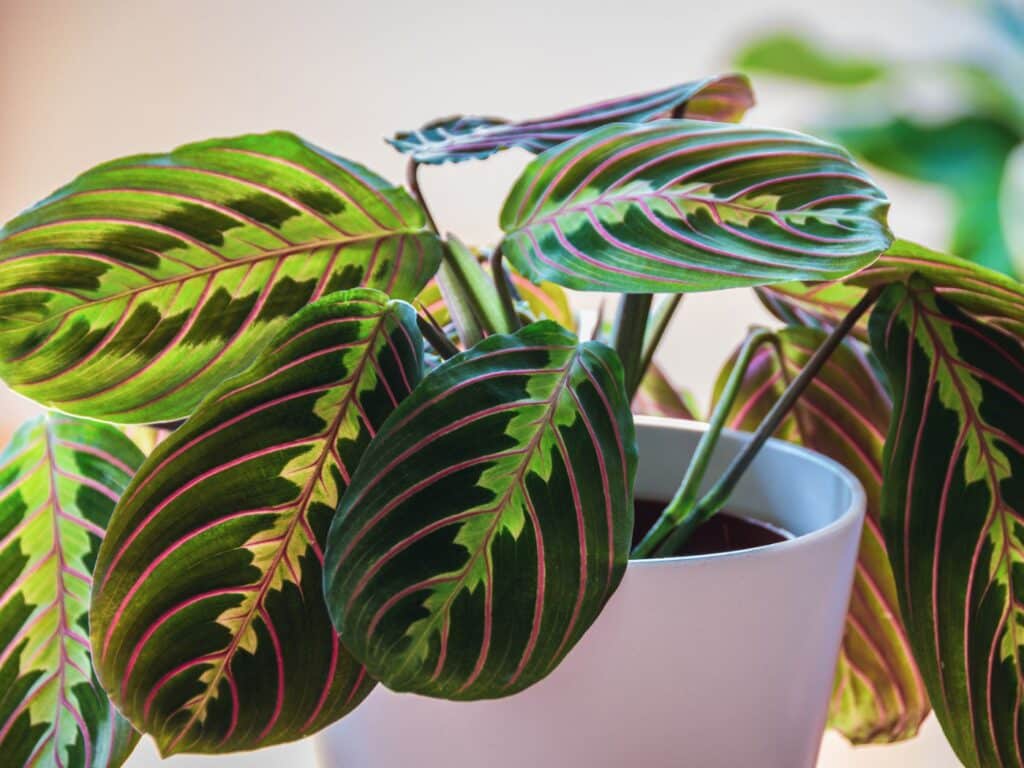Caring for a prayer plant involves more than just watering and sunlight; the soil you choose can make or break its vibrant display. If you’ve found your prayer plant struggling despite your best efforts, the issue may well lie beneath the surface.
Selecting the right soil is crucial for the health and growth of your prayer plant, ensuring it thrives and brings a touch of the tropics to your indoor garden.
Understanding the unique needs of your prayer plant can transform your approach to indoor gardening. With the right soil blend, you’ll not only prevent common issues like root rot and stunted growth but also enhance the plant’s stunning foliage and overall vitality.
Dive deeper into the world of prayer plant care with us, and discover how to create the perfect environment for your leafy companion to flourish.
Understanding Prayer Plant Soil Requirements

The Importance of Proper Soil Mix
Choosing the right soil mix for your prayer plant isn’t just about giving it a home. It’s about making sure that home is cozy and supportive, allowing your plant to thrive. The correct mix helps prevent common problems such as root rot and promotes vigorous growth and vibrant foliage.
Remember, your prayer plant’s well-being hinges significantly on the quality and composition of the soil it’s planted in. Hence, making an informed choice can shape the future health and beauty of your plant.
Key Components for Prayer Plant Soil
When prepping the ideal home for your prayer plant, three components stand out: drainage, aeration, and nutrient retention. Let’s break these down:
- Drainage: Essential for any prayer plant, a well-draining soil mix prevents water from hanging around too long and causing root rot.
- Aeration: Your plant’s roots need to breathe. Soil that’s too dense can suffocate them, impeding growth. Incorporating materials like perlite or coarse sand can improve soil structure, promoting better aeration.
- Nutrient Retention: While drainage and aeration are critical, your soil can’t be all air and no substance. Peat moss or coconut coir can be great additions, holding onto nutrients and water just long enough for your plant to take advantage.
Selecting a soil mix that balances these factors creates an environment where your prayer plant won’t just survive—it’ll flourish. Remember, caring for these plants isn’t about complexity; it’s about understanding their basic needs and meeting them with precision.
Whether you mix your own soil or opt for a pre-made blend designed for prayer plants, ensuring that your soil ticks these boxes is a step towards vibrant, healthy growth.
Choosing the Right Soil for Your Prayer Plant

Commercial vs. DIY Soil Mixes
Deciding between commercial and DIY soil mixes for your prayer plant may well feel like choosing between a gourmet meal and a home-cooked dinner. Both have their perks.
Commercial mixes offer convenience and consistency, perfectly balancing drainage, aeration, and nutrient retention to support your plant’s health. They take the guesswork out of the equation.
On the flip side, creating your own soil mix lets you play mad scientist. You can adjust ingredients to meet your prayer plant’s specific needs, mimicking its natural habitat. However, this approach requires a bit more effort and understanding of what your green buddy thrives on.
Recommendations for Pre-Mixed Prayer Plant Soil
Not all of us have the time or inclination to mix our own soil, and that’s perfectly okay. For those leaning towards the ease of pre-mixed solutions, a few standout options promise to give your prayer plant everything it needs to flourish.
Look for mixes designed for African violets or general houseplants, as these typically ensure the right balance of drainage and water retention. Brands like Miracle-Gro or FoxFarm are well-regarded in the gardening community for their quality mixes that cater to a wide range of indoor plants, including prayer plants. Remember, the goal is to create a cozy environment for your plant’s roots, allowing them to breathe while staying hydrated.
Creating Your Own Prayer Plant Soil Mix

Step-by-Step Guide to Mixing Your Own Soil
Creating your own prayer plant soil mix may well sound complex, but it’s simpler than you think. Begin by gathering your ingredients.
You’ll need a sterile container large enough to mix your soil components without making a mess. Use a clean, dry scoop or trowel for mixing to avoid introducing any unwanted pests or diseases into your blend.
First, add one part peat moss or coco coir into your mixing container. These ingredients help the soil retain moisture while allowing excess water to drain, preventing root rot.
Next, incorporate one part perlite or vermiculite to promote aeration within the soil. This step is crucial for allowing your prayer plant’s roots to breathe.
Lastly, mix in one part compost to introduce nutrients into the soil. Compost also improves the soil’s texture and fertility, supporting healthy plant growth. Mix the components thoroughly until you have a homogenous mix, and voila, your prayer plant soil is ready to use.
Essential Ingredients for a Healthy Mix
A perfect soil mix for your prayer plant requires three key components: organic matter, drainage material, and nutrients. Organic matter, such as peat moss or coco coir, holds moisture and keeps the soil light.
Peat moss has a slightly acidic pH, matching the prayer plant’s preference. Conversely, coco coir is a sustainable alternative that provides similar benefits.
For drainage, perlite or vermiculite are your go-to choices. Perlite, volcanic glass heated until it pops, ensures excess water flows freely, protecting the plant from waterlogged roots.
Vermiculite, meanwhile, retains moisture and nutrients, releasing them back to the plant as needed. Either option promotes a well-aerated soil environment crucial for root health.
Compost is the nutrient powerhouse of your mix, supplying essential elements like nitrogen, phosphorus, and potassium. It improves the soil’s overall structure, leading to stronger, healthier plants.
By combining these elements, you create a balanced environment that supports the lush growth of your prayer plant, setting you on the path to a thriving indoor garden.
Tips for Maintaining Prayer Plant Soil Health
Watering Practices for Optimal Soil Moisture
Achieving the right moisture level in your prayer plant’s soil is like walking a tightrope—too much or too little, and you’re in for trouble. Ideally, you’ll water when the top inch of soil feels dry.
This method encourages roots to seek water, promoting strong growth. Overwatering can suffocate roots and lead to rot, while underwatering stresses the plant.
Use a finger test or a moisture meter to keep things balanced, and always allow excess water to drain away. Remember, your prayer plant isn’t a fan of soggy shoes!
Signs of Soil Problems and How to Fix Them
Spotting an unhappy prayer plant often starts with the soil. Yellow leaves? Could be waterlogged soil. Dropping leaves? Perhaps it’s too dry. If you encounter these issues, don’t panic—adjustment is key.
For waterlogged soil, let the soil dry out more between waterings or consider repotting with fresh, well-draining mix. For dry soil, increase your watering frequency slightly but be cautious not to overdo it.
Additionally, integrating a layer of mulch can help maintain moisture levels and keep your plant happy. Remember, a little observation and adjustment go a long way in keeping your prayer plant thriving.
Repotting Your Prayer Plant
When to Repot Your Prayer Plant
Identifying the right time to repot your prayer plant is crucial for its growth and health. Generally, it’s time for a new home if you notice roots poking out of the pot’s drainage holes or if the plant has stopped growing despite proper care.
Another hint is when water runs straight through the pot without soaking in, indicating the plant is root-bound and the soil is exhausted. Aim to repot in the spring, giving your plant plenty of time to settle in before the growth season.
How to Choose a New Pot and Soil for Repotting
Selecting the appropriate pot and soil for your prayer plant is pivotal to its prosperity. Choose a pot that’s 1-2 inches larger in diameter than the current one to allow room for growth.
Ensure the new pot has adequate drainage holes to prevent water from pooling at the bottom. For the soil, aim for a well-draining mixture that retains moisture without becoming soggy. Mixing two parts peat moss or coco coir with one part perlite and one part compost provides the perfect balance your prayer plant craves for thriving.
Frequently Asked Questions
What is the best soil mix for a prayer plant?
The ideal soil mix for a prayer plant balances drainage, aeration, and nutrients. A homemade mix can include peat moss or coco coir, perlite or vermiculite, and compost.
Can I use commercial potting soil for my prayer plant?
Yes, you can use commercial potting soil for your prayer plant. However, ensure it’s formulated for indoor plants to provide the right balance of moisture and aeration.
How often should I water my prayer plant?
Water your prayer plant when the top inch of soil feels dry to the touch. The frequency will depend on factors like humidity and temperature.
What are signs of improper soil conditions in a prayer plant?
Yellowing or dropping leaves can indicate improper soil conditions. This usually stems from overwatering, underwatering, or poor drainage.
When should I repot my prayer plant?
Repot your prayer plant when it shows signs of root growth beyond the current pot or once every 1-2 years to replenish the soil and encourage healthy growth.
How do I choose a new pot for repotting?
Select a new pot that is slightly larger than the current one and has good drainage holes. This will ensure your prayer plant has room to grow without sitting in waterlogged soil.
Image by firn – Maritxu22/depositphotos







